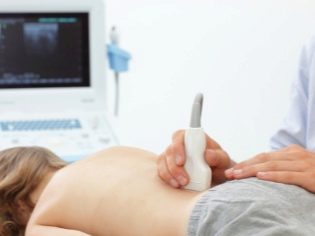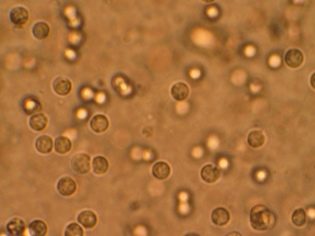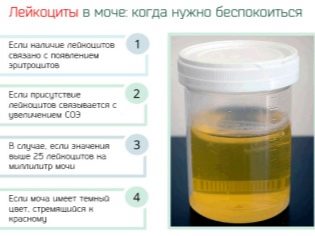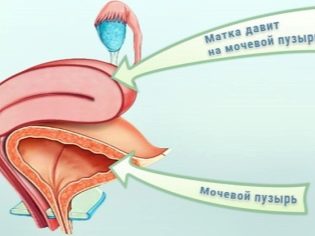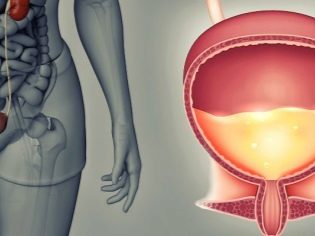Should there be leukocytes in the urine during pregnancy and what to do with an increased value?
Leukocyte cells protect the body from various infections. They may be present in the urine normally. However, the appearance of leukocytes in large numbers during pregnancy can be a very dangerous symptom.
Objectives of the analysis
In the period of carrying a baby, doctors prescribe many different laboratory tests for pregnant women. Urine is also being tested. This important clinical analysis can show even the smallest pathologies that have developed in the body of a pregnant woman.
During the period of pregnancy, the future mom must pass urine at least three times. It is especially important to conduct such studies in the 2 and 3 trimesters of pregnancy. The risk of pathology of the kidneys and urinary tract at this time is maximum.
Obstetricians-gynecologists, observing future moms, It is recommended to perform a urine test a little more often:
- In the first trimester, this study is usually appointed at each visit to the doctor. In the future, the multiplicity of passage of this survey varies.
- In the second half of pregnancy to pass a general analysis of urine should be somewhat more often. During the second trimester, experts recommend taking this test every two weeks.
- At the final stage of pregnancy, you can take a complete urinalysis almost weekly. It is especially important to conduct such diagnostics for women with serious diseases of the kidneys or urinary organs.
Obstetrician-gynecologists and therapists identify several special risk groups. They include women who have a fairly high risk of developing various pathologies of internal organs. They should undergo a general urinalysis with the determination of the number of leukocytes in it more often.
If the leukocyte cells in the urinary sediment are greatly elevated, then this may be an indication for sending a future mom to consult a urologist.
The incoming clinical indicators, which are included in the urinalysis, help professionals to establish any, even minor deviations from the norm. This allows them to identify pathology in the early stages of formation, and therefore take the necessary measures in a timely manner.
Normal performance
The presence of leukocytes in the urinary sediment is physiologically normal. This indicates the manifestation of the work of local immunity. Quite often, a high content of leukocytes in the urinary sediment is recorded in pregnant women already in the late stages of carrying a baby.
Conventional laboratory analyzers count leukocyte cells in the examined field of view. Normally, this value should not exceed 6 uniform elements.
Increased white blood cell count in the urinary sediment - always a significant reason for additional diagnostics. In this case, as a rule, auxiliary tests are assigned. The most frequently performed of them is urine analysis according to Nechyporenko. Leukocyturia in this case is manifested by an increase in leukocytes above 2000 units.
During the study, other urine values are also determined. Its specific density, color, and also the content of uniform elements are estimated.
A large number of red blood cells in the urinary sediment - manifestation of pathology. In this case, the exacerbation of glomerulonephritis or severe damage to the renal tissue should be excluded. Bleeding in the ureters or bladder can also cause this symptom.
A relatively new definable criterion - leukocyte esterase. This component secrete leukocytes. In high concentrations, this substance is determined by the death of leukocyte cells. The introduction of this indicator has significantly improved the performance of diagnostics of various pathologies.
A positive test result on leukocyte esterase indicates the presence of an inflammatory process in the renal tissue. In this case, mandatory additional tests are required. An ultrasound examination of the kidneys may also be required.
Leukocyturia
The increase in urinary leukocyte count is called leukocyturia. The development of this condition during pregnancy can lead to a variety of factors.
Under any circumstances, leukocyturia requires mandatory monitoring by doctors. The progression of this state may contribute to the development of dangerous pathologies of pregnancy.
Doctors distinguish several clinical variants of leukocyturia:
- An increase in leukocytes in the urinary sediment to 15 indicates a small process. In this case, the severity of the inflammatory process, as a rule, is moderate.
- The growth of leukocytes above 40 indicates an increase in inflammation and exacerbation of the process. This pathology, as a rule, is also accompanied by an increase in leukocyte cells and in the blood - leukocytosis.
Causes of high content of leukocytes in the urine
According to statistics, various diseases of the kidneys and urinary organs lead to the appearance in the urine of a high level of leukocyte cells.
Inflammation of the bladder
Pyelonephritis, glomerulonephritis or cystitis are the leading pathologies causing leukocyturia in pregnant women. Quite often, these diseases are recorded in women before the conception of the baby.
Inflammation of the bladder (cystitis) is also a common cause leading to the appearance of large numbers of leukocytes in the urine. This pathology can occur both in acute and in chronic form.
In most cases, the disease is accompanied not only by the appearance of leukocyturia, but also is accompanied by the development of many adverse symptoms.
Urine congestion
Leading factors in the appearance in the urine of a large number of leukocytes are stagnant. They can lead to the development of a reverse flow of urine from the ureters to the kidney. This condition is called pathological reflux.
There is stagnation due to several reasons:
- Squeezing the uterus of the urinary system, which are located retroperitoneally. This condition is quite often manifested in slender women who have a narrow structure of the pelvic bones.
- Altered hormonal background, which develops during childbirth. This process is a natural physiological response of the fetus due to its active growth and development.
- Low physical exertion, especially in the last weeks of carrying a baby. Such hypodynamia leads to an increase in weight and a decrease in good muscle tone. All these factors contribute to the development of strong stagnation in the pelvis.
Pathogenic microorganisms
Many pathologies leading to the development of leukocyturia provoke various pathogenic microorganisms. It should be noted that their massive growth and development begins to occur with a strong stagnation in the urinary tract. Bacterial colonies multiply at a fairly high speed.
If the future mom suffers from various diseases of the reproductive or urinary system, then she is often sown. numerous pathogenic microbes. Among them are various forms of staphylococci and streptococci, chlamydia, E. coli, gonococci and other microorganisms.
Reduced immunity
The appearance of a large number of leukocytes in the urine is caused by the influence of some provoking causes against the background of decreased immunity. For example, severe hypothermia can lead to the appearance of leukocyte cells in the urinary sediment. It is especially unfavorable if the lumbar region or the small pelvis is severely frozen. In this case, not only increases the risk of exacerbations of diseases of the kidneys or urinary tract, but also the internal genital organs.
It is important to note that banal candidiasis can lead to moderate leukocyturia. In this case, the source of this condition is Candida fungi, which settle on the organs of the external genital organs.
The decrease in immunity that occurs during pregnancy provokes the growth of fungal flora, which is manifested by the development of candidiasis. In this case, the number of leukocytes in the urine may be in the range of 8-20 units in the field of view.
How to suspect?
Without a special laboratory apparatus, it is quite difficult to determine leukocytes. Currently, there are special test strips that define several key indicators in the urine. You can buy them in pharmacies.
These test strips are used for screening leukocyturia. Such a study conducted at home, in any case should not be a substitute for conducting a general urine test in the laboratory.
It is possible to suspect the presence of an increased number of leukocytes in another way. In some cases, leukocyturia leads to clouding of urine discharge. Its normal color is straw yellow, transparent. A white impurity or precipitate may be a manifestation of leukocyturia.
The appearance of such an unfavorable symptom should be a good reason for going to the laboratory.
Leukocyturia, resulting from abnormalities of the excretory system, is often manifested by the appearance of pain in the lumbar region. Pain syndrome is usually of weak or moderate intensity. Quite often, pain spreads down to the groin area. When changing the position of the body pain may increase.
If only one ureter or kidney is affected, then the pain is manifested only on one side. Soreness is aggravated when the woman turns on a sore side. In some cases, the severity of pain may be unbearable. In this situation, emergency hospitalization may be required.
If, against the background of turbid urine and soreness in the lower back, a pregnant woman's body temperature rises strongly, then this sign may indicate about the onset of inflammation in the renal tissue. In this case, an urgent appeal to the doctor is required.
As a rule, aggravation of pyelonephritis is manifested in this way. This pathology during pregnancy can lead to a life threatening for a baby developing in the mother’s tummy.
Frequent urination is also a fairly frequent symptom that can occur with leukocyturia. Portions of urine usually become small in volume. A woman may feel a burning sensation or soreness while urinating. Frequent urination occurs mainly at night.
What to do with an increase in leukocytes in the urine?
First of all - do not panic! The appearance of leukocytes in the urine is an important diagnostic criterion, but does not yet determine the absolute presence of pathology. The increase of leukocytes in the urine to 20 units in the field of view requires mandatory retesting. The algorithm of actions is the following:
- For this, a general urinalysis is repeated. If there are signs of leukocyturia, then a study should be conducted on Nechiporenko.Deviations from the norm in this analysis require mandatory monitoring by the therapist.
- During the consultation, the doctor will conduct a clinical examination and collect anamnesis. Quite often it happens that during such a simple study, kidney or urinary tract diseases are detected.
- The appearance of leukocyturia is also a mandatory reason for the examination by an obstetrician-gynecologist. The appearance of a moderate number of leukocytes can also occur during exacerbation of diseases of the genital organs. If pathology has developed for this reason, then the doctor can easily establish it.
- If necessary, more advanced diagnostics conducted auxiliary ultrasound. In the early stages of pregnancy, doctors prefer, as a rule, transvaginal ultrasound.
From the 2nd trimester, it is more rational to apply transabdominal research. Such an examination is necessary, as it will allow to identify any pathology in both the mother and the baby.
For some pathologies of the kidneys and urinary tract, special methods of laboratory diagnosis are used:
- One of such specific tests is urine analysis according to Zimnitsky. With this method, doctors can study well the filtration ability of the kidneys. For this purpose, samples collected every three hours are evaluated.
- In certain situations it may also be necessary to conduct bakposeva. He is appointed in cases where the future mom against the background of white blood cells in the general analysis of the urine bacteria were detected. Bacteriological examination allows to determine the type of bacterial cells more accurately. Also using this method, you can determine the sensitivity of microbes to various antibacterial drugs.
After the diagnosis has been established, the doctor will prescribe a pregnant woman with leukocyturia signs and an appropriate regimen. To compile it, the doctor uses quite a few different criteria. It necessarily takes into account the severity of the inflammatory process, the period of pregnancy, the level of work of the expectant mother’s immune system, as well as her age and the presence of concomitant diseases of the internal organs.
Mild forms of leukocyturia are usually treated by prescribing various urosepticheskikh means. It should be noted that doctors rarely try to resort to the appointment of various antibiotics during pregnancy.
Many of these drugs can have an adverse effect on the fetus, causing it to have various defects and anomalies of prenatal development.
Comprehensive treatment prescribed by a doctor, as a rule, the following:
- Various herbal remedies are well suited as uroseptic drugs. These include: chamomile, cranberry, lingonberry leaf, currant, as well as various ready-made pharmacy fees. Brew them should be according to the instructions on the package. Typically, these infusions are appointed 2-3 times a day, 40-60 minutes after a meal.
- As a complex treatment, the combined preparation “Canephron” is also suitable. It contains a whole complex of various plant components, which have a pronounced anti-inflammatory effect on the kidneys and urinary tract. As a rule, after taking this drug, the leukocytes in the urine normalize.
- In the acute period of the disease, doctors prescribe expectant mothers to observe bed rest. Such a simple measure helps to normalize the flow of urine and reduces the severity of the intoxication syndrome. In the presence of unilateral lesions should lie on the healthy side.
- To improve urine performance, expectant mothers should always follow the nutritional guidelines. All salted and pickled foods should be completely excluded from the daily menu. An excessive amount of salt can aggravate the course of kidney pathology, which will only enhance the manifestations of leukocyturia.
- In case of severe pathology, it may be necessary to prescribe antibacterial drugs.Typically, such treatment is carried out in a hospital. In this case, the potential risk to the fetus is always evaluated. Antibiotics that do not cause teratogenic effects are selected for treatment.
For more information on why leukocytes rise in the urine, see the following video.








